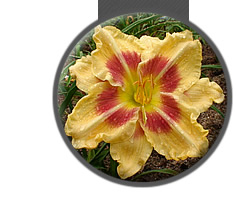
POLYMEROUS vs. POLYTEPAL
In 1995, the American Hemerocallis Society recognized a new classification of daylilies and called them "polytepals." This term was botanically incorrect. At the fall 2008 meeting of the AHS Board of Directors correctly changed the term to "polymerous."
As a leading advocate of this new form of Hemerocallis, I urge all daylily growers and hybridizers to use the term "polymerous" for flowers that are syntepalous, i.e., those that have four or more segments in each whorl that are joined at the base, forming the perianth tube as in daylilies.
The term "polytepalous" refers to multiple flower segments
that are completely separate from each other, which is not the case in Hemerocallis.
Additional Polymerous Terms
tetramerous = 4 per whorl ; a tetramer
pentamerous = 5 per whorl; a pentamer
hexamerous = 6 per whorl; a hexamer

Bobby Baxter
Happy Moose Gardens
|
Polymerous Daylily Database
I welcome you to my polymerous daylily database web site. Here you will find cultivar information relating to daylilies that are registered with the American Hemerocallis Society as blooming polymerous. The Polymerous Database is a very simple utility that provides detailed cultivar information with ease through several pre-established search pages and I will be adding advanced search capabilities to the site in the near future.
To utilize the simple search features of the polymerous database click on the appropriate search criteria listed under the "Searches" tab in the menu at the top of the page.
I consider a Hemerocallis cultivar to be a true polymerous daylily when it exhibits the characteristic in at least 50 percent of its blooms. However, I have included all registered daylilies in this database that have a recorded polymerous percentage submitted by the hybridizer/registrant. These flowers that bloom with the characteristic less than 50 percent are merely typical daylilies that have a propensity to exhibit polymerous blooms, and I do not consider them to be true polymerous cultivars.
All the flower images displayed in the polymerous database have been voluntarily submitted by daylily growers and hybridizers specifically for this project. I invite you to submit any cultivar photographs that are missing or to provide a better image than the one currently displayed in the database.
Please enjoy,
Bobby Baxter
|